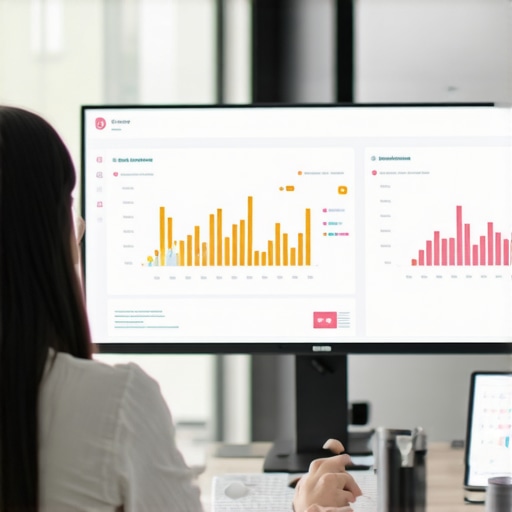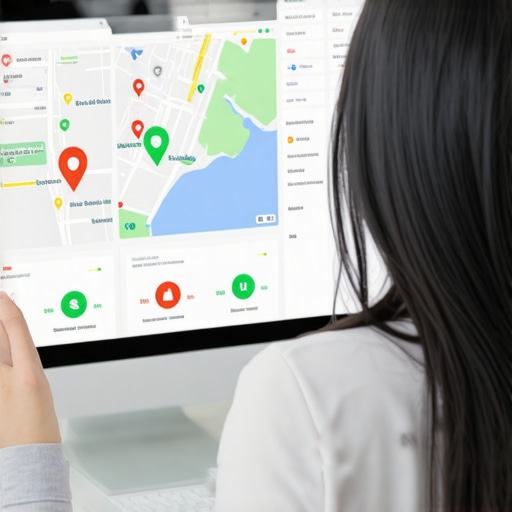My Personal Journey with CTR SEO: From Frustration to Success
When I first started focusing on local SEO, I was overwhelmed by the myriad of strategies and tips out there. I remember spending hours tweaking my website, only to see minimal improvements in my local rankings. It wasn’t until I delved into the world of click-through rate (CTR) optimization that I truly began to see a difference. Today, I want to share my experience and insights, especially on how effective CTR SEO tips can dramatically enhance your local search presence and user engagement.
Understanding the Significance of CTR in Local SEO
CTR isn’t just about getting clicks; it’s about attracting the right audience and signaling to search engines that your content is relevant and valuable. I learned that a higher CTR can improve your local rankings, as search engines interpret clicks as a sign of trustworthiness and relevance. For instance, optimizing your titles and meta descriptions with compelling calls-to-action has helped me attract more local customers. If you’re curious about how to boost your CTR, there are proven strategies worth exploring.
How I Applied CTR Strategies to Elevate My Local Business
One tactic I found particularly effective was tailoring my Google My Business listing with engaging images and localized keywords. I also experimented with meta description tweaks that resonated with my neighborhood audience. The result? A noticeable uptick in calls, visits, and conversions. Additionally, I integrated structured data markup to help search engines better understand my offerings, which further improved my visibility.
What Really Drives User Engagement and Higher Rankings?
In my experience, combining CTR optimization with user engagement signals is a winning formula. Engaged visitors spend more time on your site, share your content, and leave reviews—all of which factor into your local SEO. I also made it a point to respond promptly to reviews and questions, fostering trust and authenticity. To deepen my understanding, I referred to authoritative sources like Moz’s SEO guidelines, which emphasize the importance of user experience and engagement.
Why does engagement matter as much as clicks?
Engagement metrics, such as bounce rate and dwell time, are vital indicators for search engines. They help confirm that your visitors find what they’re looking for, boosting your rankings further. I encourage you to explore how these signals can be optimized alongside CTR for maximum impact.
If you’re ready to harness these insights, I invite you to share your experiences or ask questions in the comments below. Together, we can learn and grow our local SEO strategies.
Are You Leveraging User Behavior Insights to Maximize CTR and Engagement?
Understanding the nuanced relationship between user behavior and search engine algorithms is crucial for any local SEO expert. When visitors click on your listing, they’re sending a clear signal to Google about your relevance and trustworthiness. But how deeply are you analyzing and optimizing for these signals? Advanced tools and analytics can reveal patterns such as time spent on page, bounce rates, and conversion paths, unlocking new opportunities to refine your CTR strategies. For example, A/B testing different meta descriptions and titles based on user engagement data can significantly improve your click-through rates.
Integrating Structured Data to Enhance Rich Snippets and Visibility
Structured data markup, such as Schema.org, can make your listings stand out with rich snippets—like reviews, ratings, and event details—that attract more clicks. Implementing these elements not only improves your visibility but also provides users with immediate value, increasing the likelihood of engagement. Google rewards these enhancements with higher CTRs, which in turn can elevate your local rankings. For detailed implementation guidance, consult our comprehensive guide.
Why Do Engagement Signals Matter As Much As Clicks in Local SEO?
While a high CTR is desirable, engagement metrics such as dwell time, pages per session, and review activity provide a deeper understanding of user satisfaction. Engaged visitors are more likely to convert into loyal customers and leave positive reviews, which further boost local SEO signals. Google interprets these signals as indicators of content quality and relevance, creating a virtuous cycle of improved rankings and visibility. To optimize for both CTR and engagement, consider enhancing your website’s user experience, ensuring fast load times, and providing clear calls-to-action.
How Can You Fine-Tune Your Local SEO Campaigns for Maximum Impact?
Beyond the tactical tips, it’s essential to adopt a holistic approach that combines technical SEO, compelling content, and active reputation management. Regularly update your Google My Business profile, gather authentic reviews, and monitor your engagement metrics through analytics tools. For more advanced strategies, explore data-driven engagement tactics that can drive sustained growth. Remember, SEO is an ongoing process; staying informed and adaptive is key to maintaining your competitive edge.
Would you like to share your experiences with CTR optimization or need tailored advice? Drop a comment below or connect with us via our contact page. And if you’re eager to learn more about boosting your local search presence, be sure to check out our other insightful articles.
My Personal Insights on Advanced CTR Optimization and User Engagement
Over the years, I’ve come to realize that mastering CTR and user engagement isn’t just about implementing quick fixes; it’s about understanding the nuanced behaviors of your audience and continuously refining your approach. One aspect I’ve found particularly compelling is how personalization can dramatically influence user interaction. Tailoring your meta descriptions and snippets based on user location, preferences, or previous interactions can make your listings irresistible. For me, experimenting with dynamic snippets that adapt to user intent often results in a noticeable uptick in clicks and engagement.
The Power of Behavioral Data in Fine-Tuning Your Local SEO Tactics
Incorporating behavioral analytics into your strategy can unlock new levels of precision. Tools like heatmaps, session recordings, and advanced analytics reveal exactly how visitors interact with your site after clicking through. For example, I discovered that users often bounce from certain pages because of slow load times or confusing layouts. By optimizing these technical elements and aligning content more closely with their expectations, I saw a significant improvement in dwell time and conversion rates. For those interested, exploring data-driven engagement tactics can be transformative.
How Do You Balance Technical SEO and User Experience for Optimal Results?
This question has been central to my journey. It’s easy to get caught up in technical SEO metrics like structured data, schema markup, or keyword density, but if your site isn’t user-friendly, those efforts won’t fully pay off. I learned that seamless navigation, fast loading times, and mobile responsiveness are as crucial as your meta descriptions and backlinks. Investing in a well-designed, intuitive website ensures that once users click, they stay engaged and convert. For advanced strategies, I recommend reviewing comprehensive guides that integrate technical and user-centric SEO practices.
Integrating Rich Media to Enhance CTR and User Engagement
Another layer I’ve added to my strategy involves rich media—videos, infographics, and interactive elements. These not only make listings more attractive but also provide immediate value that encourages clicks. For instance, embedding short testimonial videos in your GMB profile or website can boost trust and clickability. I’ve found that incorporating such elements, especially in local directories, can significantly improve engagement metrics. Rich media, combined with structured data, creates a compelling reason for users to choose your listing over competitors.
How Can You Leverage Customer Feedback and Reviews to Reinforce Your CTR and Engagement?
Customer reviews are gold mines for insights and trust-building. Responding authentically to reviews and highlighting positive feedback in your snippets can influence click behavior. I’ve also integrated review-rich snippets into my website using schema markup, which helped my listings stand out with star ratings and review summaries. According to Moz, reviews impact local rankings and CTR, making active reputation management a cornerstone of advanced SEO strategies. Engaging with your community and showcasing genuine customer stories can foster loyalty and encourage more interaction.
If you’re exploring these deeper levels of optimization, I encourage you to reflect on your current data and experiment with new tactics. Share your experiences or ask questions in the comments—I love hearing how others are pushing the boundaries of local SEO. Additionally, don’t miss exploring more advanced strategies to boost your local rankings. Remember, continuous learning and adaptation are the keys to sustained success in this dynamic field.
Leveraging Behavioral Analytics for Precision Optimization
In my ongoing journey through local SEO mastery, I’ve come to appreciate the transformative power of behavioral analytics. Tools like heatmaps, session recordings, and detailed analytics dashboards reveal the subconscious patterns of your visitors — where they linger, what they ignore, and where they bounce. By dissecting this data, I’ve discovered that subtle technical adjustments, such as reducing page load times or clarifying call-to-action buttons, can significantly increase dwell time and conversions. This data-driven approach is vital for refining your CTR tactics and ensuring each click is meaningful.
Can Deep Behavioral Insights Unlock New Levels of Engagement?
Absolutely. Deep diving into user behavior allows you to craft highly personalized experiences that resonate on an individual level. For instance, I experimented with dynamic meta descriptions that adapt based on user location or previous interactions. This personalization boosted my CTR by making listings more relevant and enticing. Furthermore, integrating behavioral data with A/B testing frameworks enables continual refinement, ensuring your strategies evolve with your audience’s preferences. For more insights on harnessing data to boost engagement, visit this comprehensive guide.
How Do You Harmonize Technical SEO with User Experience for Optimal Results?
My experience has shown that technical SEO and user experience are two sides of the same coin. Over-optimizing for keywords or schema markup without considering usability can backfire by alienating your audience. Conversely, a beautifully designed site that loads slowly or is difficult to navigate won’t convert visitors into customers. Striking the right balance involves technical mastery—fast, mobile-friendly sites, structured data, and schema markup—paired with intuitive navigation and compelling content. This dual approach ensures that once a user clicks, they stay engaged and convert. For advanced strategies, I recommend reviewing our detailed SEO integration guide.
Incorporating Rich Media to Amplify CTR and Engagement

Rich media—videos, infographics, interactive elements—are game-changers in local SEO. Embedding customer testimonial videos or quick walkthroughs can dramatically increase trust and clickability. I’ve found that incorporating short, localized videos into my Google My Business profile and website not only enhances the user experience but also boosts engagement metrics. These elements serve as immediate proof of quality and relevance, compelling users to choose your listing over competitors. Rich media, coupled with structured data, creates an irresistible combination for both users and search engines.
How Can Customer Feedback and Reviews Reinforce Your CTR & Engagement?
Customer reviews are a goldmine of social proof. Authentic responses to reviews and highlighting positive feedback within your snippets can significantly influence click behavior. I’ve integrated review-rich snippets using schema markup, which displays star ratings and review summaries directly in search results. This visual cue acts as an immediate trust signal, encouraging more clicks. Active reputation management—responding to reviews and sharing customer stories—further fosters loyalty and engagement. For more advanced review strategies, see our expert guide.
If you’re eager to push your local SEO boundaries further, I invite you to explore these tactics and share your experiences or questions. Remember, continuous experimentation and refining are the hallmarks of sustained success in local SEO.
Things I Wish I Knew Earlier (or You Might Find Surprising)
1. The Power of Micro-Moments
Early in my journey, I underestimated how small tweaks—like optimizing snippets for micro-moments—could dramatically increase clicks. Recognizing when your audience is actively seeking local solutions and tailoring your content to those moments turned out to be a game-changer for my CTR.
2. User Intent Trumps Keywords
Focusing solely on keywords felt natural, but I discovered that aligning your meta descriptions and titles with user intent yields better engagement. When I started thinking about what users really want, my CTR improved significantly, and search engines rewarded that relevance.
3. Visual Elements Matter More Than I Expected
Adding compelling images and videos to my Google My Business profile and website increased user engagement and CTR. I realized that rich media not only attracts attention but also builds trust, making visitors more likely to click and convert.
4. The Subtle Art of Personalization
Personalized meta descriptions based on user location or previous interactions increased my CTR by making listings feel more relevant. This taught me that small personal touches can create a big difference in local SEO performance.
5. Reviews as a Double-Edged Sword
While reviews boost trust and CTR, managing them actively and responding genuinely has been crucial. I found that engaging with customer feedback turns reviews into powerful assets that reinforce your credibility and visibility.
6. Technical SEO and UX Need to Coexist
Investing in fast-loading, mobile-friendly sites combined with structured data and a seamless user experience has been essential. Balancing technical SEO with good design ensures visitors stay engaged after clicking.
Resources I’ve Come to Trust Over Time
- Moz’s SEO Guidelines: A comprehensive resource that emphasizes the importance of user experience and engagement, which helped me understand the bigger picture.
- Google’s Rich Results Documentation: Essential for implementing structured data and rich snippets—my go-to for technical enhancements.
- Backlinko’s SEO Strategies: Practical, tested tactics for improving CTR and rankings that I’ve applied with success.
- HubSpot’s Content Marketing Blog: Offers insights on content personalization and user engagement strategies that resonate with local audiences.
Parting Thoughts from My Perspective
Mastering CTR SEO is an ongoing process that combines technical finesse, compelling content, and genuine user engagement. From my experience, focusing on authentic interactions and visual storytelling amplifies your local search presence more than just keywords or backlinks alone. If this resonated with you, I’d love to hear your thoughts—share your experiences or ask questions in the comments. Remember, the journey to better local SEO is personal, and every small improvement counts towards building a trusted, engaging online presence.

